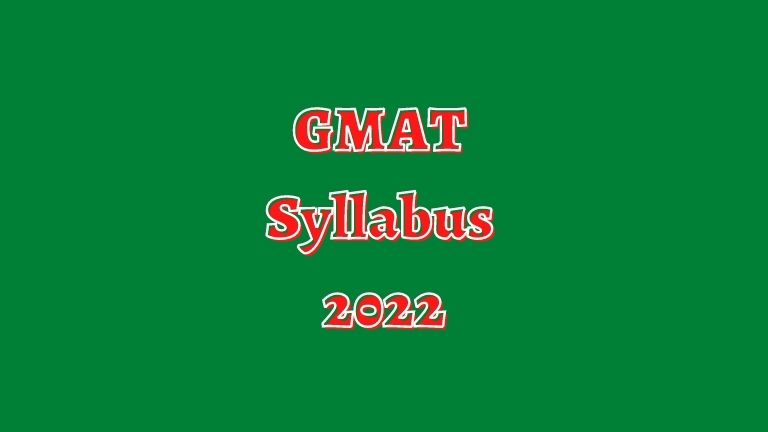GMAT Syllabus: The Graduate Management Admission Test is an adaptive computer test utilized.we are giving the GMAT Syllabus details . as a resource to analyze a candidate’s analytical and quantitative credibility. and language proficiency. It caters to candidates looking to associate with leading B-Schools around the world.Which as management graduates (MBA). The acceptability of GMAT scores is way more prevalent. than any other aptitude test.which will be in over 2300 colleges and for 7000 programs. Please find the GMAT syllabus below and also the latest updated exam pattern.
- Analytical Writing Assessment
- Integrated Reasoning Section
- Quantitative Section
- Verbal Section
The GMAT score is a crucial prerequisite for admission into graduate management and business programs like the MBA. Before we look at the GMAT Syllabus.So, it is advisable to check out the GMAT Exam Pattern to get some context. At the time of examining the GMAT Syllabus.
As a priority on GMAT Syllabus and Exam patterns, this writing will cover the topics on,
GMAT Syllabus – Highlights
| Sections | Number of Questions | Duration |
|---|---|---|
| Analytical Writing | Analysis of Argument | 30 minutes |
| Integrated Reasoning Section | 12 questions | 30 minutes |
| Optional Break | 10 minutes | |
| Quantitative Section | 37 questions (15 questions in Data Sufficiency and 22 in Problem Solving) | 75 minutes |
| Optional Break | 10 minutes | |
| Verbal Section | 41 MCQs (12 Critical Reasoning, 14 Reading Comprehension, 15 Sentence Correction) | 75 minutes |
GMAT Exam Pattern
The GMAT Exam will be a 3 hours 7 minutes online test. It consists of 4 across-the-board sections, i.e.:
| Sections | Number of Questions | Time Limit (mins.) |
| Analytical Writing | 1 question (01 essay) | 30 |
| Integrated Reasoning | 12 questions | 30 |
| Quantitative | 31 questions | 62 |
| Verbal | 36 questions | 65 |
| Total | 80 questions | 187 |
The maximum number of marks that can attain is 800. Although there are only four sections, the patterns are calculated for each of the four sections, along with an added score of the two sections of Quantitative Aptitude and the Verbal Ability combined. Hence, in total, there are five components as the scoring elements. These five components make up the final score. The marks for the other sections are viewed separately.
GMAT Syllabus
Four sections of the GMAT Exam Syllabus
- Analytical Writing
- Integrated Reasoning
- Quantitative Aptitude Section
- Verbal Reasoning Section
The GMAT exam consists of 4 sections. As with any examination of importance. The candidate must be careful with the exam syllabus before preparing for the declared exam. Also, before the candidate can create their practice, they need to examine the GMAT Syllabus closely.
The GMAT Syllabus is given in broad terms on the official GMAC website. This article will talk about the overall GMAT Syllabus and try dissecting it according to the different sections for your better understanding.
1. Analytical Writing Assessment
This exam area requires you to analyze a given argument and critique it. The argument topics are mostly of general interest and may be related to business. AWA will check your ability to organize your thoughts and use the given proof to support your viewpoint.
2. Integrated Reasoning
The GMAT section requires exploring and considering information submitted in multiple formats. IR questions will challenge both your quantitative and verbal skills. Question types can vastly grouped in this.
- Multi-source reasoning – questions will ask candidates to synthesize tables, graphs, diagrams, compare, interpret or apply the information presented in written passages and other types of visual representation.
- Table Analysis – questions come to you to determine statistics, ratios, proportions or probabilities, etc., from a given spreadsheet-like table with a drop-down menu.
- Graphics interpretation – fill-in-the-blanks type questions to and answers based on given bar graphs, line graphs, scatterplots, and bubble graphs.
- Two-part analysis – questions will ask you to calculate proportion, determine trade-offs, etc. and choose answer options that will give in tabular format.
3. Quantitative Reasoning
The Quantitative section of the GMAT has questions with two types of groups. I Problem Solving and Data Sufficiency. Topics are traditionally grouped beneath:
- Arithmetic – proportions, sets, counting methods, Numbers and their powers and roots, fractions, decimals, percentages, discrete probability.
Arithmetic
|
|
- Algebra – equations, functions, inequalities, absolute value, exponents.
Algebra
|
|
- Geometry – lines and angles, polygons, circles, solids, coordinate geometry.
Geometry
|
|
- Word problems – rate, time and work, mixtures, discounts, profit and loss, geometry problems, simple and compound interest, measurement problems, and data interpretation.
Note: The GMAT syllabus for quantitative reasoning doesn’t allow a calculator for this section of the test. Thus, it is essential to brush up on your number sense, mainly if it’s been some time since you worked with numbers. With proper GMAT Quant Books, candidates can also excel in quant skills.
4. Verbal Reasoning
The GMAT verbal ability section is timed to 65 minutes, within which a candidate expects to complete the extension. The candidate has about 65 minutes to complete the room for the verbal section. The department consists of three different types of questions, namely,
- Reading comprehension
- Critical reasoning
- Sentence correction
- Reading comprehension asks you to refer to a passage of up to 350 words and answer questions based on the main idea, supporting ideas, context, style, tone, inferences, etc.
- Critical reasoning – questions check you on statement construction, argument evaluation, and formulating/evaluating a plan of action.
- Sentence correction – questions are organized into agreement, diction, grammatical construction, idiom, logical predication, parallelism, rhetorical structure, and verb form.
Topics that will be covered in the GMAT Verbal Reasoning section are as follows:
| Critical Reasoning | Rhetorical construction of the sentences | Sentence correction including finding error or omission | Reading unseen passages |
| Subject-verb agreement | Misplace modifiers | Countable Vs Uncountable | Parallelism |
GMAT Reading Comprehension
In this section, candidates have to read unseen passages which are of 350 words and answer multiple-choice questions based on the paths—while making an unbiased decision. You need not have known any extra intricate information regarding the topic. Instead, you should only set your concepts right and understand the relationship between various entities involved.
GMAT Reading Comprehension: Categorizing RC Questions
Categorizing RC questions will increase your ability to interpret GMAT Verbal Ability as a whole section. It means that you will enhance your ability to comprehend what questions are being asked in the GMAT verbal section and how best to answer them. What does it take for a test taker to perform that on-spot mental exercise? You will also be able to analyze the questions to identify essential bonds and the unsaid repercussions directing towards the continuation of the excerpt. Here are some of the most prominent types of RC questions asked in GMAT:
Preparation Tips for GMAT Syllabus
To study on your own actually, you need a few good GMAT textbooks and resources, along with study material, motivation, and self-discipline. On the other hand, if time is a constraint and you need professional guidance to confirm a competitive edge in GMAT exam preparation, joining a GMAT coaching center in your location is the better option. Check out the Practice Tips for GMAT Syllabus in detail.
|
|
Frequently Asked Questions on GMAT Syllabus
Yet, have more inquiries about the GMAT? Read the repeatedly most continually asked questions on GMAT and GMAT Syllabus 2022.
#1. What is the Math Syllabus of GMAT?
Ans: GMAT Quantitative Aptitude Section comprises Data Sufficiency and Problem Solving. This section is designed to test the aspirants’ proficiency in solving problems with a mathematical approach.
#2. Is the GMAT exam difficult?
Ans: The GMAT exam tests various skillsets like thinking critically, analyzing data, and drawing conclusions using reasoning skills. According to an estimate, only 5-6% of nominees can score more than 720+. So, one needs to acquire these skills to gain a decent score to acknowledge their dream B-school.
#3. How is the GMAT score calculated?
Ans: the account is diving into Total GMAT scores. Here is the overall performance before scores given for the Quantitative and Verbal sections. Then the raw calculation is converted to a number in the entire score range. GMAT scores are written during breaks of 10. There can be a standard error of 30-40 points.
#4. How to get a perfect GMAT score?
Ans: One must have a technique to qualify for the GMAT to get a perfect score on the GMAT.
1st step: Candidates are required to study regularly
2nd step: Practice study material consistently
3rd Step : Discover the fundamentals
4 the Step: Focus on increasing your speed
5th Step : Practice mock tests and learn where you are being clung.
#4. When to start training for the GMAT test?
Ans: Ideally, one should start preparing for the GMAT exam at least six months before presenting the test results. Candidates should have a minimum of six to eight weeks to train for the GMAT test if they are already knowledgeable about the GMAT test.
#5. What are some of the GMAT Quant topics that can be expected in the GMAT test?
Ans: Downward are some of the topics that must be protected to qualify for the GMAT Quants:
| Multiples and factors | Percentages | Fractions |
| Decimals | Number properties | Permutation and combination |
| Profit and loss | Simple and compound interest | Speed, time, and distance |
| Probability | Lines and angles | Triangles |
| Rectangular solids and cylinders | Circles | Quadrilaterals |



